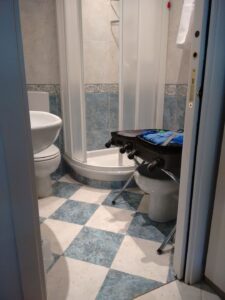On my very first trip to Europe I could barely lift my backpack, whose content  included enough soap, shampoo, and tampons to get me through three months. But it eventually dawned on me: Just like us, people all over the world take care of their sore throats, their periods, their cuts and scrapes—and have the products and medicines to do so. So now, when it comes to toiletries, my trick for packing light is to take just enough to get me started. Then I replenish my supplies at a pharmacy (which Brits refer to as a “chemist”), grocery, or department store on the road.
included enough soap, shampoo, and tampons to get me through three months. But it eventually dawned on me: Just like us, people all over the world take care of their sore throats, their periods, their cuts and scrapes—and have the products and medicines to do so. So now, when it comes to toiletries, my trick for packing light is to take just enough to get me started. Then I replenish my supplies at a pharmacy (which Brits refer to as a “chemist”), grocery, or department store on the road.
Don’t be nervous about finding what you need! I’ve easily located not only the basics to restock my packing list below, but also things for minor emergencies: first-aid and anti-itch creams, laxatives, decongestants…even crutches. And more medications are available over the counter in Europe than in the US. Try asking a European pharmacist for what you need (most speak English) and they may be able to give it to you without a prescription—or make a quick call to a doctor to OK it.
Here’s what I pack—in small amounts, and restocked as needed on my trip [see Part 1 for my clothes packing list]:
Health & hygiene:
· Toothbrush, floss, toothpaste (You’ll see Colgate and Crest in Europe, but why not try something different? The Italian brand Marvis has flavors like licorice and ginger mint. Kids’ toothpastes are widely available, too.)
· Antiperspirant (Deodorant is easy to find in Europe; antiperspirant is less common.)
· Nail file and clippers
· Sunscreen (But brace yourself: it’s usually more expensive, and the highest SPF’s are harder to find.)
· Body and face lotions
· Brush and comb
· Conditioner (I don’t bother packing shampoo—every hotel provides it—but very few offer conditioner.)
· Hair styling product
· Razors
· Makeup (I take only a face powder, eyeliner, and lipstick. If you need to replace something in Europe, brands like Maybelline and L’Oreal are widely available—but so are many we don’t see in the US, so have fun experimenting!)
· Lip balm (I stock up on my favorite European brand, Labello, each time I’m there. It’s inexpensive and doesn’t get “goopy” on my lips like Chapstick.)
· Tampons and pads
· Cotton swabs
· Vitamins
· Tylenol/acetaminophen (a.k.a. paracetamol in Europe), ibuprofen
· Benadryl/diphenhydramine (for allergies/allergic reactions, and as a sleep aid)
· Pepto Bismol tablets
· Individual Kleenex packs (It’s rare to find tissues in European hotel rooms, but they’re so handy for pinch-hitting as a napkin or TP.)
· Hand sanitizer
Other necessities:
· Guidebook sections (It feels sacrilegious to my fellow book-lovers, but I highly recommend you slice up your guidebooks before you travel. Use an X-acto knife to cut through the spine to separate out just the chapters you’ll need. If you’re only going to Paris and the Loire Valley, why haul around the 400 other pages from your France guidebook? And yes, I still carry actual books. One time I relied on e-versions on my iPad, only to discover that it became almost too hot to touch when I was out sightseeing under the blazing Italian sun. And when I’ve downloaded guidebooks on my phone, not only is it too small for deciphering fine print and detailed maps; it’s also hard to read in bright sunlight.)
· Maps (I’m old-school in this department, too. I sometimes use GoogleMaps for directions, but I’m a “maphead” and enjoy studying and using “real” maps. My favorites are the laminated Streetwise city maps: sturdier than paper, and rain-proof.)
· Phrasebook (I use Google Translate to look up individual words, but for conversation I prefer phrasebooks that offer whole sentences grouped by topic—menus, medical issues, chatting, shopping, etc.)
· Cell phone and charger (My cell plan is expensive to use abroad, so I buy a prepaid SIM card from a mobile phone shop in Europe. They start at around $25.)
· Sunglasses, eyeglasses, and my optometrist’s prescription (in case I need to get a replacement pair)
· Plug adapters (I bring two so I can charge my phone and tablet at the same time. Voltage converters aren’t usually needed for phones or computers.)
· Moneybelt (I can’t recommend this highly enough. It may feel awkward at first, but you’ll get used to it quickly, and then enjoy the security of knowing it can’t be stolen. I’ve tried the neck-pouch type but—at least for a woman—it creates an obvious and unattractive protruding square on your chest.)
· Passport (kept safely in my moneybelt, with a copy of its photo page kept separately in my suitcase, to make it easier to replace if lost or stolen)
· Debit and credit cards (also kept in my moneybelt, with account numbers and customer service phone numbers kept separately in my suitcase)

· Cross-body bag and daybag (My go-to sightseeing bag is a canvas cross-body bag, for easy access but more security than a purse. But if I plan to do a lot of hiking, I also take a very lightweight little knapsack to use on my trekking days.)
· Neck pillow (An inflatable one smushes down to nothing in your bag.)
· Eye mask (Even if you don’t normally sleep with one at home, it’s nice to have in case your hotel room’s too bright or your roommate stays up late.)
· Addresses of folks back home (because these days it’s a real treat for them to receive a postcard)
· Mini first-aid kit (including bandaids and triple-antibiotic cream)
· Reusable water bottle
My surprising but must-have extras:
· Denture-cleaning tablets (Even if I didn’t have a dental appliance, I’d bring them for sanitizing my reuseable water bottle.)
· Silica gel (Save up a few of those little packets that come in your pepperoni bag, new shoe box, or vitamin jar. If your phone or camera gets wet, put it in a zip-lock bag with these to dry it out.)
· Travel wallet (I use a canvas one that’s lighter than my everyday leather wallet, and fits the dimensions of Euro bills, some of which are bigger than dollars.)
· Small notepad and pen (Sometimes real paper comes in handy. I can write out my question for the local who can’t understand my attempt at his language, jot a list for my picnic or souvenir shopping, or tear out a sheet for a note slid under my friend’s hotel room door.)
· Zip-lock bags (Endlessly useful for picnic supplies, keeping dirty socks from stinking up your suitcase, creating an icepack for an injury or headache, and for creating your own tiny hand-washing-machine when your hotel-room sink doesn’t have a drain stopper. Fill up a bag with your undies, a squeeze of soap, add water, zip it up, then shake!)
· Insect repellent (I’m accustomed to the nearly bug-free Northwest; in Europe I get eaten alive. “Natural” insect repellents are more common in Europe; if you want full-strength DEET, sometimes it’s not on display and you’ll have to ask a pharmacist to get it from behind their counter.)
· Earplugs (The squishable foam kind are a sanity saver when faced with

snoring roommates, fellow train or plane passengers who talk all night, thin hotel walls, and that charming inn that end up being next to a disco.)
· EarPlanes (To avoid painful, plugged ears in flight on ascent and descent, these equalize the pressure.)
· Washcloths (European hotels never have them. Bring your own, or at a European “euro store,” buy a microfiber “cleaning rag”—they feel like terry cloth but don’t get mildewed like cotton.)
· Microfiber Packtowl (After hand-washing your laundry, roll it up in one of these and wring it out or stomp on it. They keep absorbing even when wet. Your clothes will dry much faster. Also handy as a makeshift beach towel.)
· Elastic clothesline (Please don’t drape your wet laundry over Mr. and Mrs. Bed-and-Breakfast Owner’s fifth-generation wood furniture! Hang it up—but inexpensive hotel rooms often have few hangers, so you’ll need something like this.)
· Natural-tear eye drops (After hours on a plane or a long day sightseeing in the sun and with potential new allergens, these offer relief.)
· Baby powder (Prevents chafing; rubbed on feet, can help prevent blisters; and an allover dusting can dry you off and improve your scent when there’s no time for a shower between hot summer sightseeing and heading back out to dinner!)
· Small foot callus file or pumice (Lots of walking and standing means calluses can form even in perfectly-fitting shoes. I keep them in check with a quick daily file so they don’t cause pressure.)
· Fold-up tote bag (for carrying your picnic…and the souvenirs that won’t fit in your suitcase on the way home)
Umbrella (A raincoat hood blocks your vision; it’s easier to sightsee with an umbrella. I bring one that collapses to only a few inches long.)
· Bobby pins or headbands (Because humidity levels that are different from home may cause your hair to behave in new and crazy ways!)
